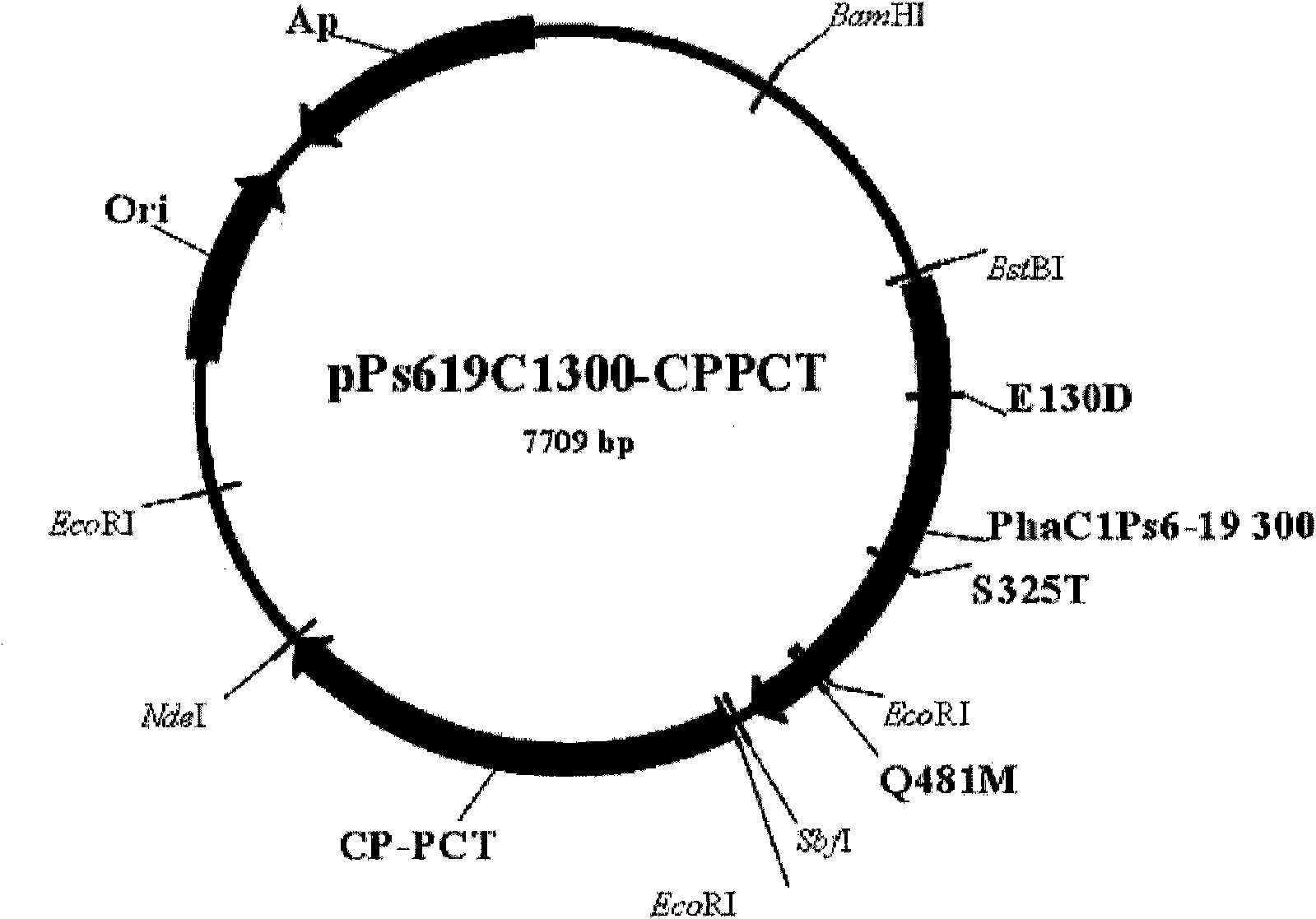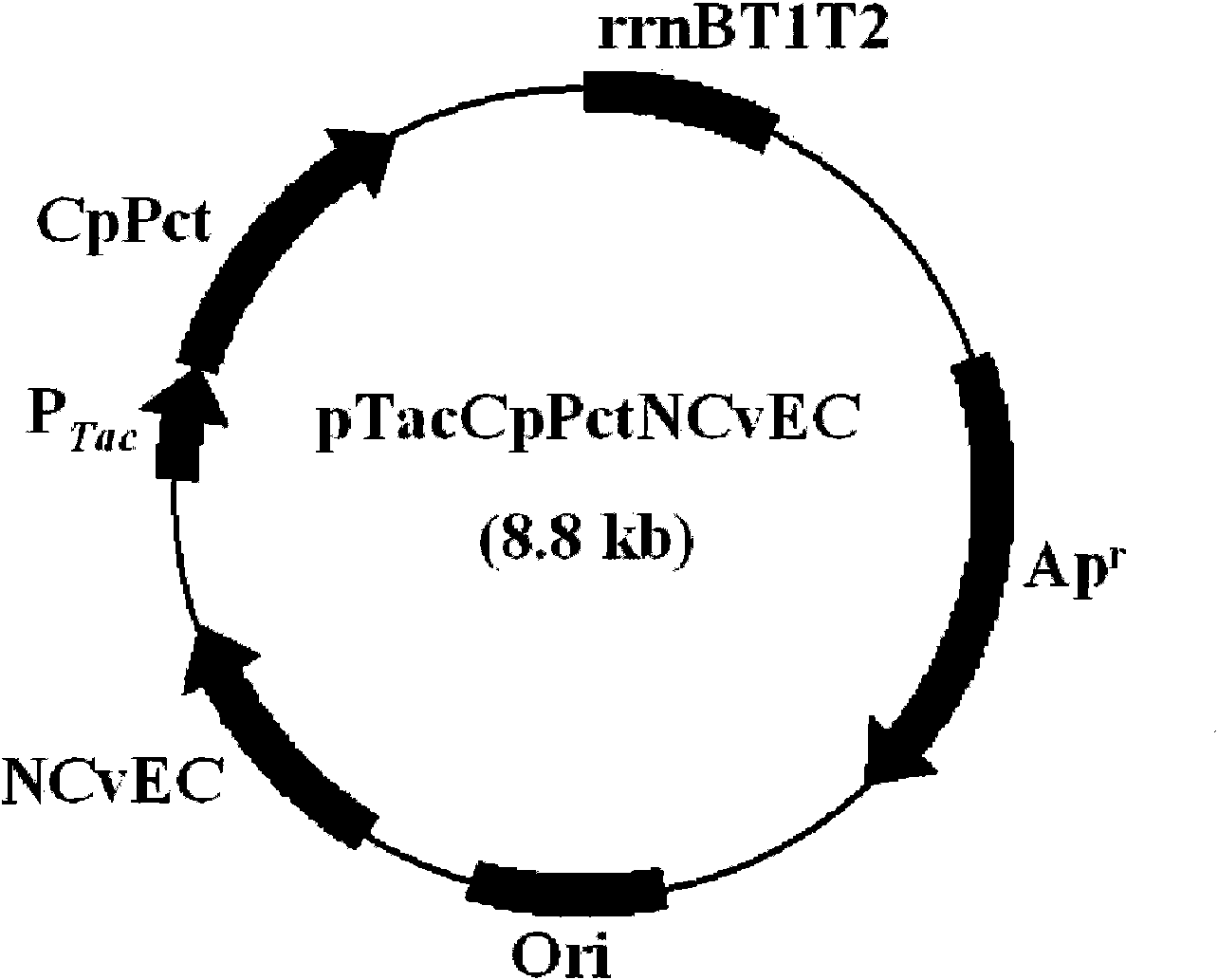Copolymer containing 3-hydroxyalkanoate unit and lactate unit, and its manufacturing method
A technology of lactate terpolymer and hydroxyalkanoate, applied in the field of copolymers, can solve the problems of weak PHA synthase activity, difficult to remove solvent or chain coupling agent, complicated preparation method of high molecular weight PLA, etc.
- Summary
- Abstract
- Description
- Claims
- Application Information
AI Technical Summary
Problems solved by technology
Method used
Image
Examples
Embodiment 1
[0039] Embodiment 1 comprises the construction of the recombinant plasmid of pct gene and PHA synthase gene
[0040] Recombinant plasmids containing pct gene and PHA synthase gene, pPs619C1300-CPPCT and pTacCpPctNCvEC, were constructed to prepare copolymers containing 3-hydroxyalkanoate units and lactate units.
[0041] (1) Construction of pPs619C1300-CPPCT plasmid The propionyl-CoA transferase (CP-PCT) gene derived from Clostridium propionicum was used as the pct gene, and the PHA derived from Pseudomonas 6-19 was used to synthesize Enzyme gene as PHA synthase gene.
[0042] Such as figure 1 Construct the operon of the constitutive expression system that simultaneously expresses PHA synthase and CP-PCT. CP-PCT is known to be toxic to host microorganisms. That is, in the tac promoter or T7 promoter expression system induced with IPTG (this system is widely used for the expression of recombinant proteins), all the microorganisms died shortly after adding the inducer. For th...
Embodiment 2
[0075] Example 2: Preparation of MCL 3-hydroxyalkanoate-lactate copolymer
[0076] Transform Escherichia coli WB101 (Park and Lee, J.Bacteriol.185, 5391-5397, 2003) with the recombinant plasmid pPs619C1300-CPPCT comprising pct gene and PHA synthase gene constructed in Example 1, to obtain Escherichia coli WB101 / pPs619C1300-CPPCT. WB101 is reported to be a fadB E. coli mutant effective in producing MCL-PHA (Korean Patent No. 10-0447531).
[0077] Transformants were cultivated in the following two steps to obtain MCL 3-hydroxyalkanoate-lactate copolymers: first, in 100 mL LB medium containing 100 mg / L ampicillin (Bacto TM Tryptone (BD) 10g / L, Bacto TM The transformed recombinant Escherichia coli WB101 / pPs619C1300-CPPCT was cultured in yeast extract (BD) 5g / L, NaCl(amresco) 10g / L) for 24 hours, and then the culture medium was centrifuged at 1000g for 15 minutes at 4°C to collect the cells .
[0078] In the LB medium (Bacto TM Tryptone (BD) 10g / L, Bacto TM The collected cel...
Embodiment 3
[0081] Example 3: Preparation of 3-hydroxybutyrate-MCL 3-hydroxyalkanoate-lactate terpolymer
[0082] Transform Escherichia coli WB101 [W3110(fadB::Km) Park and Lee, J.Bacteriol.185:5391,2003] with the recombinant plasmid pPs619C1300-CPPCT comprising pct gene and PHA synthase gene constructed in Example 1, To obtain Escherichia coli WB101 / pPs619C1300-CPPCT. WB101 is reported to be a fadB E. coli mutant effective in producing MCL-PHA (Korean Patent No. 10-0447531).
[0083] The transformants were cultivated to obtain 3-hydroxybutyrate-MCL 3-hydroxyalkanoate-lactate terpolymers by the following two steps: first, in 100 mL LB medium containing 100 mg / L ampicillin ( Bacto TM Tryptone (BD) 10g / L, Bacto TM The transformed recombinant Escherichia coli WB101 / pPs619C1300-CPPCT was cultured in yeast extract (BD) 5g / L, NaCl(amresco) 10g / L) for 24 hours, and then the culture medium was centrifuged at 1000g for 15 minutes at 4°C to collect the cells .
[0084] In the LB medium (Bacto ...
PUM
 Login to View More
Login to View More Abstract
Description
Claims
Application Information
 Login to View More
Login to View More - R&D
- Intellectual Property
- Life Sciences
- Materials
- Tech Scout
- Unparalleled Data Quality
- Higher Quality Content
- 60% Fewer Hallucinations
Browse by: Latest US Patents, China's latest patents, Technical Efficacy Thesaurus, Application Domain, Technology Topic, Popular Technical Reports.
© 2025 PatSnap. All rights reserved.Legal|Privacy policy|Modern Slavery Act Transparency Statement|Sitemap|About US| Contact US: help@patsnap.com



